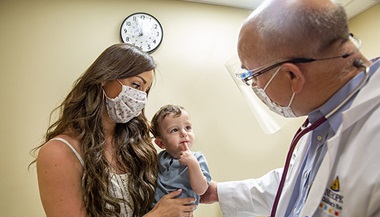Patient Story
Congenital Diaphragmatic Hernia: Eleanor's Story
Patient Story Highlights
- CDH affects 1 in 3,000 pregnancies.
- Kimberly knew she needed a second opinion, so she reached out to Johns Hopkins All Children's Hospital in St. Petersburg, Florida.
- David Kays, M.D. and the CDH team helped Kimberly prepare for delivery and saved Eleanor's life.

Midway through her third pregnancy, Kimberly Fawbush of Indianapolis was concerned that her ultrasound was taking an unusually long time. When the sonographer grew quiet and her physician entered the room, she knew something was wrong.
They referred her to a high-risk pregnancy specialist, who performed a second ultrasound and soon told Kimberly that her baby had a congenital diaphragmatic hernia (CDH).
“My first thought was that a hernia doesn't sound like such a big deal,” she recalls. “Then she told me that babies with this condition typically don’t live long after birth, and that there really wasn't much more they could do for me.”
Kimberly was devastated.
“I sat in the parking lot and cried. When I finally got home, I started doing some of my own research because I didn't understand congenital diaphragmatic hernia. Everything I read just made me feel worse.”
Congenital diaphragmatic hernia (CDH) is a rare birth defect, affecting approximately one in 3,000 pregnancies. It is usually diagnosed before birth, often around the 20-week ultrasound visit. CDH occurs when the diaphragm (the muscle that separates the chest from the abdomen and plays a big role in breathing) does not form properly. The result is a hole in the diaphragm that lets the intestines, stomach, spleen and sometimes the liver move into the chest, stopping the lungs from developing normally.
Kimberly and her husband, Corey, were not ready to start grieving. They thought a second opinion at a children’s hospital near their home in Indianapolis might shed more light on the baby's medical condition and provide some hope. But they weren’t given much additional information, and Kimberly continued her own research.
She found an article on CDH written by David Kays, M.D., director of the Congenital Diaphragmatic Hernia Program at Johns Hopkins All Children’s Hospital, and learned that his team has achieved a greater than 90 percent survival rate for CDH patients he has treated during the past 20 years, compared to the national survival rate of 50-70 percent.
Kimberly had found a reason to hope.
A support group for CDH families put Kimberly in touch with Joy Perkins, the nurse coordinator for the CDH program at Johns Hopkins All Children’s. Several phone conversations with Perkins and Kays followed, giving Kimberly every reason to expect that her baby would have an excellent chance to survive and do well.
When expectant parents learn that their baby has CDH, they often choose to end the pregnancy based on the initial data they received, Kays explains. “This is a very personal decision. But we are certainly going to give parents accurate data and the hope that their baby can do very well.”
Soon the couple were on their way from Indiana to St. Petersburg—aboard their first commercial flight—to meet with Kays, Perkins and the obstetrician who works with the CDH team.
“When we met Dr. Kays, we both cried,” Kimberly recalls. “He went through the diagnosis and test results and was very thorough. He reassured us that there was hope for Eleanor (the name we had already chosen for our baby) and encouraged us not to give up. Joy gave us hope, too, and was very helpful in arranging our appointments and providing information.”
They returned to Indiana to prepare for a longer stay on the Johns Hopkins All Children’s campus. Corey was uneasy about leaving his job to come to Florida for an extended period and having to figure out schooling issues for their two little boys.
“But I knew we had to go,” he said.
The entire family arrived in St. Petersburg when Kimberly was 34 weeks pregnant. Eleanor was born a month later on September 1, just as Tropical Storm Hermine was passing through Florida. Kays and his team were right there in the delivery room, ready to intubate Eleanor and get her breathing. Then came a brief elevator ride to the cardiovascular ICU, where Kays performed surgery on Labor Day, right in Eleanor’s hospital room. She responded well and slowly began to get better.
“Eleanor’s long-term outlook is excellent,” says Kays. “Here’s a baby that people thought wasn't going to survive or, if she survived, wouldn't have a very good outcome. She’s going to be terrific. Her future is very bright.”
Eleanor and her family are already back home in Indianapolis and will return for yearly checkups with Dr. Kays. Everyone looks forward to those visits. Dr. Kays and his team follow their CDH patients throughout childhood and beyond age 18 to know how they do over time.
The family appreciates everything that Kays and Perkins have done to help their journey. “It made a big difference to have one person in control of her care, and for Eleanor to have a team of CVICU nurses,” Kimberly says. “They know your baby well, so you don’t have to worry when you’re not in the room. It gives you peace of mind.
My favorite memory will always be the first time I her, only 18 days after she was born. With the original, diagnosis we received, I didn't think I would ever get to hold her. It was such a great feeling."
Kimberly
Center for Congenital Diaphragmatic Hernia
Led by CDH expert David Kays, M.D., our team combines compassionate care, innovative techniques, and cutting-edge technology and equipment to treat babies with CDH.




